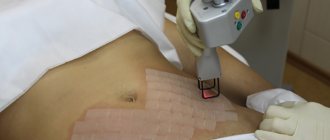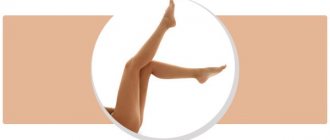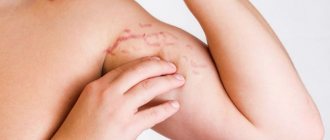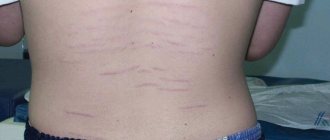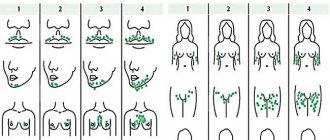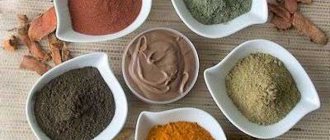Many people know firsthand about this problem. Here are just some figures that may indicate the relevance of correcting this nosology: up to 70% of expectant mothers experience similar “changes”; 23% of teenage girls note the appearance of stretch marks in the mammary glands. Real figures in different age groups, taking into account different incidence rates, have not been published, and it is not possible to count the number of calls.
The solution to this problem by specialists comes down to preventing the occurrence of this condition. Correction of stretch marks is a complex task that requires an integrated approach, consistency of therapy, material and time costs, compliance with all doctor’s recommendations on a healthy lifestyle and educational activities on the part of aesthetic medicine doctors. Many specialists refuse treatment for stretch marks, believing that it does not bring the desired effect and is difficult to correct, since it is already formed connective tissue.
Very often, doctors suggest correcting stretch marks as scars, but this is an absolutely independent nosology both from the point of view of etiopathogenesis, clinical and morphological picture, and when choosing treatment methods.
Striae (striae distensae, striae gravidarum) - stripe-like skin atrophy, stripe-like atrophoderma, "stretch marks" - a kind of skin atrophy in the form of narrow sunken wavy stripes, localized mainly in places of greatest stretching of the skin (thighs, buttocks, chest, abdomen).
Striae are a serious cosmetic defect that appears mainly in young people, as well as in women during pregnancy. Both of them are concerned about the aesthetic issue.
Etiology and pathogenesis
When forming a problem, they distinguish
:
- predisposing factors (genetic predisposition, mechanical factors, disorders in the pituitary-adrenal cortex system, physiological conditions associated with hormonal imbalance in the body and increased production of stress hormones (puberty, pregnancy));
- provoking factors (intense sports, sudden fluctuations in body weight, growth spurt, heavy lifting).
Experts believe that the main reason for the formation of the nosology is hormonal imbalance: the predominance of the role of adrenocorticotropic, thyroid-stimulating hormones, as well as hormones of the adrenal glands, thyroid gland and gonads. No less importance is given to excessive stretching of the skin during pregnancy in women (on the abdomen, mammary glands), in women and girls who have sharply gained weight (on the hips, waist and buttocks), in athletes when building muscle mass (in the shoulder area). belt, hips)
Striae can be a symptom of diseases (Marfan syndrome, Itsenko-Cushing's disease, hypercortisolism) formed during juvenile hypercortisolism, during puberty in children who are rapidly gaining body weight, taking anabolic hormones in athletes, against the background of diencephalic syndrome.
In the pathogenesis of striae, the leading role is given to a decrease in the synthesis of collagen and elastin by fibroblasts while maintaining the ability to synthesize metalloproteases (collagenase, elastase), thus, in the spectrum of cells of the fibroblastic series, fibroblasts predominate, synthesizing enzymes that destroy collagen and elastin - the main proteins that maintain the strength of the skin. As a result, with excessive stretching of the skin caused by one of the above etiological reasons, the skin ruptures, the destruction of its mesh layer occurs while maintaining the integrity of the epidermis. Collagen and elastic fibers and blood vessels tear, and a “failure” forms in the skin.
Stretch marks. Striae.
The effectiveness of treatment for stretch marks is influenced by how long ago they occurred. Only recent stretch marks that appeared less than a year ago can be eliminated completely or their appearance significantly reduced. But, alas, it is practically impossible to get rid of old stretch marks.
In the treatment of stretch marks, a comprehensive course is required, built on the combination and alternation of different techniques. This is a painstaking and lengthy process that requires discipline and patience. The appearance of already formed whitish scars can only be somewhat reduced by laser or other methods of resurfacing, leveling the relief of stretch marks and the surrounding skin.
Chemical peeling . The action of chemical peeling is based on the application of strong acids to the scars, which, by burning the epidermis, activate the skin's production of its own collagen. For chemical peeling, alpha hydroxy acids, trichloroacetic and phenolic acids are used. Phenolic acids have the most active and effective effects, but their use may entail the risk of serious adverse reactions. Due to the extreme pain of the procedure, phenol peeling is performed under anesthesia and has contraindications due to the high toxicity of the active substance (for example, heart and vascular disease). The effect of trichloroacetic and alpha hydroxy acids is not as deep and milder, but also requires compliance with all precautions. Achieving a positive result is greatly influenced by adequate pre-peeling skin therapy and the professionalism of the specialist performing the procedure. Chemical peeling is a medical procedure and requires appropriate qualifications and practical experience.
Laser peeling . Laser peeling is preceded by special preparation. Before performing the procedure, it is recommended to apply creams with a high content of ascorbic acid to the skin for 1-2 months. Laser peeling is performed in a hospital, under general anesthesia. During the manipulation, the doctor treats scarred areas of the skin with a laser beam, burning them out layer by layer. The whole procedure takes no more than an hour. Typically, discharge occurs within a day, but outpatient treatment is prescribed for the next 2 weeks. After exposure to the laser, redness and swelling appear on the skin, reminiscent of a burn. These areas will need to be treated with special restorative creams. It is not recommended to sunbathe for 3 months, so it is better to plan laser peeling for autumn or winter.
Plastic surgery . The most effective and radical method of getting rid of stretch marks is to eliminate them surgically. During surgical abdominoplasty, or abdominoplasty, excess skin of the anterior abdominal wall is excised along with stretch marks. The risk of surgical intervention is always associated with the possibility of purulent complications, long wound healing, and the formation of a rough postoperative scar. After abdominoplasty, sutures are usually removed within 7-10 days, and full recovery occurs after two weeks.
Wraps . For minor, recently developed stretch marks, seaweed wraps (thalassotherapy) can be used. Spirulina seaweed improves skin tone and elasticity, saturating it with natural vitamins and microelements. An algae mask is applied to dry and clean skin, a film and a thermal blanket are applied, which allows you to warm up the body and keep warm. This promotes better penetration of beneficial substances from algae into the skin. Then the algae mass is washed off with plain water. The course of treatment ranges from 6 to 12 procedures.
After seaweed wraps, the skin noticeably improves its tone, turgor and relief. Fresh (up to six months) stretch marks may go away completely. An even better effect is achieved by combining thalassotherapy with ultrasound therapy and vitamin A derivatives (retinol). The lifting effect (increasing skin tone) is combined with the effect of peeling (removing dead cells of the stratum corneum of the epidermis) and lymphatic drainage (removing excess fluid). As a result, muscles are tightened, skin is smoothed and stretch marks disappear. But this method is effective only for fresh and slightly pronounced scar changes.
The occurrence of stretch marks is associated with deep damage to the layers of the skin, so their treatment is not always effective. If the appearance of stretch marks is not caused by pregnancy, but is accompanied by other physiological changes (increased blood pressure, weight gain, hair growth on the face, chest and back), then most likely this condition is associated with disorders of the endocrine system and requires the help of an endocrinologist.
Clinical picture
The clinical picture of stretch marks depends on the morphological properties of the skin, the degree of stretching, hormonal levels, and concomitant pathology. Striae can be single or multiple. Length ranges from 1.0 to 10.0 cm, width from 1.0 to 6.0 mm. Arranged radially or parallel. The color of the striae changes. According to the classification of stages, the inflammatory and atrophic stages are distinguished.
Inflammatory stage (“young” stretch marks up to 6 months) – color varies from purple-red to light pink. An important criterion is also that between the torn fibrous structures there are cellular elements, as well as a large number of paretically dilated vessels. There is stagnation of blood.
Atrophic stage (“old” stretch marks after 6 months) – color varies from white to whitish with a pearlescent tint. In this case, they represent a cavity, the walls of which are formed by orderly arranged collagen fibers. There are no cellular elements or vessels.
The relief has a different configuration (striae can be flush with the skin, either retracted or convex). The clinical picture depends on the area, degree and depth of damage to the fibrous structures of the dermis.
Russian classifications have not been used, so below is a classification that is widely used in Europe.
Classification of striae, author: Philippe Depres (1996), Evgenia Ranneva (2012)
| Stage | Duration | Process characteristics | Clinical picture | Striae color |
| Stage I | Up to 6 months | Aseptic inflammation | In rare cases, convex | From pink to red-purple |
| Stage II A | From 6 months to a year | Attenuation of the inflammatory process, formation of atrophic deformations of the skin | Absence (presence) of noticeable depression, “stepped relief” (-) | Pink with a bluish tint |
| Stage IIB | From a year or more | Atrophic skin deformation | Absence (presence) of noticeable depression | Skin color white |
| Stage III A | From a year or more | Atrophic skin deformation | <1 cm wide “stepped” (+) "ladder runs" (+) | Lighter than normal skin tone, white |
| Stage III B | From 5 years or more | Atrophic skin deformation | <1 cm wide | Lighter than normal skin tone, pearly whites |
| Stage IV | From 5 years or more | Severe atrophic deformation of the skin | ›1 cm wide "stepped" (++) "ladder runs" (++) | Lighter than normal skin tone, pearly whites |
Treatment methods. Short review
Pathogenetic schemes for correcting the condition prescribed by a specialist must be reasonable, comprehensive, and consistent. The sooner the correction begins, the greater the chances of getting positive results.
During the inflammatory stage, a sufficient number of vessels and many cellular elements remain in the affected area (mostly fibroblasts that secrete cytokines, biologically active substances, growth factors, enzymes). In this case, the tissue retains its potential for recovery. Striae in the atrophy stage have fewer vessels and cellular elements (especially fibroblasts), so the potential for restoring a cosmetic defect is less and decreases with age due to an increase in regeneration time. As a result, procedures for correcting stretch marks should be aimed at stimulating blood circulation and microcirculation, metabolic processes, fibroblasts, their synthetic and proliferative activity, targeted delivery of nutrients (vitamins and microelements), increasing tone and softening scar tissue.
Before starting correction schemes for this nosology, it is first necessary to exclude endocrine pathology. If it is detected, it is necessary to correct the underlying disease and only then carry out cosmetic procedures in areas with formed stretch marks. It is worth remembering that work is carried out not only on the defect itself, but also on the surrounding tissue. The correction program is selected individually, taking into account the stage of the process.
The main methods of correction: local use of cosmetics (home and professional care), chemical peels (TCA, phenol) with preliminary abrasion, injection techniques (mesotherapy, revitalization, contour plastic), intradermal biostimulation, physiotherapeutic correction (microcurrent, magnetic thermal therapy, electrophoresis, phonophoresis, vacuum massage, cryotherapy), laser therapy (ablative and non-ablative lasers).
What do stretch marks look like on your arms?
Before stretch marks appear on the muscles of the arms, a person begins to experience a burning sensation due to damage to the epidermis. Sometimes this unpleasant sensation can be accompanied by itching. Later, redness in the form of stripes appears on the hand. They gradually become larger. When these areas heal, they are very different from healthy skin. They look like burgundy or white stripes that form at the site of damaged tissue. Fresh stretch marks are usually red in color, and over time they fade and become less noticeable. In girls, stretch marks often form during pregnancy. In men, they appear due to a sharp gain or loss of muscle mass. In this case, the skin does not have time to adjust, so its integrity is compromised.
Use of cosmetics (home and professional care)
At home, the patient is obliged to carefully care for areas that are risk areas for the occurrence of this nosology. It is recommended to douse with cold water, contrast shower, and self-massage with hard mittens. It is possible to use baths with aromatic oils. After water procedures, apply external products, creams containing vitamins A, E, C, collagen and elastin hydrolysates, chamomile, tea tree, and chestnut extracts. The creams are applied with soft, smooth, stroking movements. Professional care includes mud and algae wraps. Course of wraps: 10–12 procedures 2–3 times a week. The advantages lie in the availability of the method and the preventive approach (the ability to start using it at any time, in any age group, at different stages of formation).
When prescribing cosmetic care, we must remember that this is only an additional method of correction to the main methods of treatment. At a young age and in the early stages of pregnancy, care can be regarded as a preventative method for the formation of stretch marks.
How do stretch marks begin during pregnancy and is it possible to avoid them?
All about pregnancy
Author: Vlada 01:00, November 18, 2015 11351 0 0
So, what are striae? In common parlance they are called stretch marks on the skin. They occur during the process of stretching the skin, which most often occurs due to sudden weight gain, rapid weight loss or pregnancy. The number of stretch marks, as well as their appearance (white, purple) mainly depend on the elasticity of the skin. Some, for example, do not even know what it is, since their skin has a high level of elasticity. However, those who are less fortunate - do not despair, it is possible to get rid of stretch marks, as well as prevent their appearance.
At what stage of pregnancy do the first stretch marks appear?
Above we determined why stretch marks appear during pregnancy,
Now let's find out what month to expect them. The first stretch marks may appear on the chest already in the first trimester, since the mammary glands are one of the first to enlarge when a woman is in an interesting position. At the end of the second and beginning of the third trimester (when the belly begins to actively grow), the skin on the abdomen also stretches greatly, which can lead to purple lightning patterns. The same “drawings” appear on the thighs of pregnant women.
And yet, it is worth paying attention to the fact that very often stretch marks appear only in the 9th month, and only in one or two places. Also, most mothers claim that throughout their entire pregnancy they did not have a hint of such defects, but immediately after childbirth unpleasant patterns appeared on the skin. As a rule, 8 out of 10 expectant mothers are not able to resist this phenomenon.
Skin care will reduce the risk of stretch marks
If you are interested in a method - how to prevent stretch marks during pregnancy,
then it’s better to take care of your skin in advance, using moisturizers from the early months. Problem areas are considered to be the chest, abdomen and thighs (upper and lower parts), so these areas should be given special attention when applying stretch mark treatment. This way, you nourish your skin with all the necessary vitamins and minerals, softening the process of stretching during weight gain.
There are remedies to prevent stretch marks during pregnancy
, such as special creams, gels, milk or oil, they all enrich and nourish the skin, giving it additional elasticity, which will help avoid external damage to the skin. Olive oil is in good standing against the occurrence and treatment of this kind of defects. It is known for its beneficial properties for the body, but these components have the same wonderful effect on the skin.
Preventative measures to combat future stretch marks
As a basic preventive measure, you can use several methods before conceiving a child. By following this point, you will put your body in order and prepare it for the upcoming stress.
- The first thing you need to do before pregnancy is to normalize your weight. The most optimal weight level reduces the occurrence of stretch marks by almost half;
- proper nutrition. A well-balanced diet rich in vitamins and minerals, which the expectant mother’s body will need, will help protect the skin from deformation when the fetus takes all the vital “juices” from the mother, and the skin loses its health;
- Another point can be called a contrast shower, it is very useful for blood circulation and collagen fibers. You can also conduct a course of wrapping before pregnancy.
Be more attentive to your body, any signs of stretch marks during pregnancy
– this is a lack of vitamins and nutrients in your skin, which makes it unstable to changes.
Tags: stretch marks during pregnancy
Revitalization
This method allows you to replenish the volume and create the most favorable environment for proliferation, migration and differentiation of fibroblasts. Frequency of 6–8 procedures once every 2–3 weeks, the ability to combine in one session with mesotherapy. This allows you to get the most pronounced effect. If you use the monomethod, it is necessary to additionally stimulate blood flow and microcirculation, as well as administer drugs that will help nourish skin cells.
One of the new generation revitalizants, which can be said to be “two in one,” are Jalupro preparations . All Jalupro preparations contain an amino acid functional cluster (glycine, proline, lysine, leucine) and unstabilized hyaluronic acid (HA).
Corrections with Jalupro drugs
/
Hydroxylated forms - hydroxyproline and hydroxylysine play an important role in the formation and stabilization of the three-dimensional structure of collagen and elastin, protect them from the effects of proteolytic enzymes, stimulate epidermal cells and increase the level of skin hydration. However, it should be noted that proline and lysine take part in the synthesis of collagen and elastin, and their hydroxylation occurs after inclusion of a protein molecule in the polypeptide chain.
The amino acid glycine, when administered intradermally, significantly increases the flexibility of the collagen molecule.
Levorotatory isomer of the essential amino acid leucine takes part in the synthesis of almost all proteins, including collagen and elastin. L-leucine helps restore skin after injury and surgery.
Thus, the intradermal administration of amino acids provides fibroblasts with building material, normalizes the processes of catabolism and anabolism of protein structures, reduces the rate of their degradation, stimulates the production of tissue growth factors (TGF β), new collagen and elastin, restoring the normal structure of the skin.
Another equally important component of Jalupro is unstabilized HA. The HA molecule is capable of providing transport of the amino acid cluster of the drug, rapid and pronounced tissue hydration, and stimulating the processes of proliferation, differentiation and migration of skin cells, including fibroblasts.
Men's opinion about stretch marks
We have studied the reviews and opinions of men about the shortcomings of the female body, including stretch marks, and we want to assure the fair half of humanity: you can relax and not hide the harmless white lines that remain after childbirth or losing weight.
MICHAEL:
“I don’t understand what women see so terrible in these barely noticeable veins on the skin.
I also have these on my sides, now I don’t want to wrap myself in a pareo when I’m on the beach or pool. What if stretch marks appeared in childhood while a person was growing? Or is he a professional athlete? And even more so, you shouldn’t be upset if your body is no longer perfect after childbirth.
After all, a woman in later stages carries a rather impressive-sized person inside her. So stretch marks are nothing.”
SERGEY:
“I think that stretch marks are the same as moles, freckles or body hair.
After two pregnancies, my wife has a lot of white stretch marks on her stomach, but this does not make her any less attractive in my eyes. For some reason she is embarrassed by them and wants to remove everything. I don’t mind if she wants it that way, all women strive to be perfect. But on the other hand, every white line on the beloved’s body reminds us that we are parents and touches us to tears.”
ILYA:
“My wife and I both gained a fair amount of weight at one time.
From a measured family life and all sorts of goodies. So I’ll tell you that I have even more stretch marks on my body than hers. Then we also lost weight together. Of course, stretch marks are here to stay. They are quite noticeable, especially when the skin tans, but they don’t bother me at all. And I tell my wife all the time that this is nonsense.
There are so many things in life that you have to worry about that there’s no time for stretch marks. An absolutely far-fetched problem by those who have nothing to do except show off their butt on social networks.”
Lasers
The laser principle of correction, due to increased damage, stimulates fibroblasts, creates conditions for skin regeneration and favors the restoration of the structure of the dermis. The recovery period proceeds with the formation of a crust, rehabilitation takes 3–4 weeks.
Table 2. Recommendations for methods of correcting stretch marks depending on their timing of occurrence
| Timing of occurrence | Drugs and correction methods |
| Pregnancy and lactation |
|
| Stage of inflammation |
|
| Atrophy stage |
|
Causes of stretch marks
The appearance of stretch marks is not just the result of overstretching of the skin. Stretch marks (striae) are the outcome of the healing of skin collagen and elastin fibers after microtrauma, i.e. their scarring.
The occurrence of stretch marks is caused by increased secretion of cortisol, a hormone from the adrenal cortex. Its hypersecretion leads to stretching, thinning, and then rupture of the skin fibers with the subsequent appearance of stretch marks (striae).
The cause of fiber ruptures and their subsequent scarring may be insufficient elasticity of the skin or its poor regenerative ability. Internal microtraumas of the fibers lead to the growth of connective, i.e., scar tissue in places where there are tears.
The reasons for the appearance of stretch marks in the thighs, buttocks, abdomen, and chest can be very different: puberty, pregnancy, and significant weight fluctuations. Adolescents in adolescence, pregnant women, athletes - all those who, for one reason or another, quickly gain body weight - are susceptible to stretch marks. The hereditary factor also plays a role if stretch marks run in the family of older women. Another reason for the appearance of stretch marks may be hormone replacement therapy for diseases of the endocrine system.
In people who are forced to take steroid hormones for a long time (hydrocortisone, prednisolone and other adrenal hormones), as well as in patients with Itsenko-Cushing syndrome, stretch marks can appear over the entire surface of the body and on the face. Such stretch marks are more pronounced in length, width and body surface area than stretch marks of pregnant women or teenagers.
